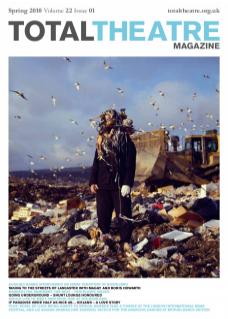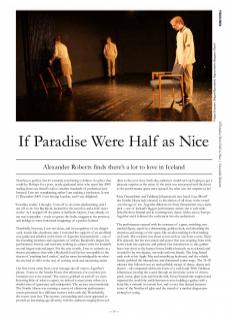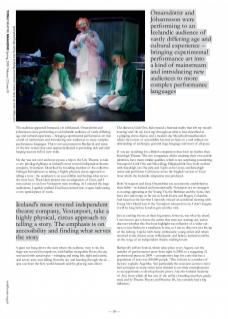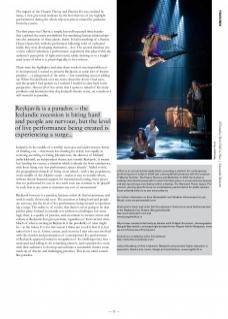Nowhere is perfect, but it’s certainly comforting to believe in a place that could be. Perhaps for a poor, newly-graduated artist who spent late 2009 surfing from one friend’s sofa to another standards of perfection have lowered. I am not complaining, rather I am making a confession. It was 11 December 2009, I was leaving London, and I was delighted.
‘Goodbye reality,’ I thought. ‘I am off to do some daydreaming, and I am off to do it in Reykjavik, Iceland for the next five-and-a-half sweet weeks.’ As I stepped off the plane at Keflavik Airport, I was already on my way to paradise – ready to ignore the faults, exaggerate the positives, and indulge in some fantastical imaginings of a perfect Iceland.
Thankfully, however, I was not alone, and in recognition of my dangerously tourist-like, daydream state, I recruited the support of an unofficial tour guide and sidekick in the form of Ásgerður Gunnarsdóttir – one of the founding members and organisers of artFart, Reykjavik’s largest live performance festival, and currently working as a dance critic for Iceland’s second largest national paper. For the next month, I was to embark on a theatre attendance duet with a Reykjavik local far less susceptible to the charm of ‘anything but London’, and far more knowledgeable on what the city had to offer in the way of exciting work and interesting artists.
Our first event came from a text message tip-off sent to Ásgerður’s phone. ‘Come to the Nordic House this afternoon, for a mystery performance not to be missed.’ The secrecy grabbed us and off we went. Knowing little of what to expect, we arrived to meet many others in a similar state of ignorance and anticipation. The secrecy was intentional. The Nordic House was running a season of afternoon performance events presented by a different mystery artist each day. Wonderfully, the events were free. The mystery surrounding each event appeared to provide an interesting age-diversity, with the audience ranging from toddlers to the over-sixty. Each day, audiences would turn up hoping to get a pleasant surprise as the name of the artist was announced and the doors to the performance space were opened. So, what was our surprise to be?
‘Erna Ómarsdóttir and Valdimar Jóhannsson’s new band, Lazy Blood!’ the Nordic House lady cheered, to the elation of all those in the crowd over the age of ten. Ásgerður filled me in: Erna Ómarsdóttir was a lucky pick – one of Iceland’s biggest performance artists, she is well established both in Iceland and in contemporary dance circles across Europe. Ásgerður and I followed the excitement into the auditorium.
The performance opened with the entrance of a giant, twitching, two-masked figure, caped in a shimmering, golden cloak, and absorbing the attention and energy of the space, like an alien making its first landing on Earth. The costume was about as low-tech as one from a retro Doctor Who episode, but the movement and power that was erupting from within the cloak was explosive and primal. Our introduction to this golden beast was short as the human forms, hidden beneath, were released and revealed to be two figures, one male and one female. The long-haired male took to his Apple Mac and microKorg keyboard, and the volatile female grabbed the microphone and dominated centre-stage. The 15–20 minutes that followed was an unclassifiable merge of dance, drama and theatre – all compacted within the form of a rock band. With Valdimar Jóhannsson steering the sound through an electronic storm of electropunk, metal, glam rock and Nordic folk, Erna Ómarsdottir sculpted and ruptured the world she and Jóhannsson were building together with a body like a tornado in a music box, and a voice that danced between tones of the Northern Lights and the sound of a mother dragon protecting her young.
The audience appeared bemused, yet exhilarated. Ómarsdóttir and Jóhannsson were performing to an Icelandic audience of vastly differing age and cultural experience – bringing experimental performance art into a kind of mainstream and introducing new audiences to more complex performance languages. This is not uncommon in Reykjavik and many of the few venues that exist appear dedicated to providing rich and challenging seasons full of new work.
My day was not over and next up was a trip to the City Theatre, to take a very privileged glimpse at Iceland’s most revered independent theatre company, Vesturport. Described by founding member of the collective Víkingur Krístjánsson as taking a ‘highly physical, circus approach to telling a story’, the emphasis is on accessibility and finding what serves the story best. Their latest project was an adaptation of Faust, and I was curious to see how Vesturport were working. As I entered the large auditorium, I quickly realised I had been invited into a space harbouring a very special piece of work.
A giant net hung above the seats where the audience were to sit; the stage was covered in trapdoors, with hidden trampoline floors; the rig was laced with aerial ropes – swinging and rising left, right and centre; and actors were seen falling from the sky and bursting through the air – spat out from the fiery world beneath and the glowing stars above.
The director, Gisli Örn, had created a fictional reality that left my mouth ‘wowing’ and ‘oh my God-ing’ throughout what is best described as a gripping circus drama, and a modern day Meyerhold manifestation where the notion of accessibility has tied its heart to a well utilised understanding of archetype, gestural stage language and most of all space.
If you are searching for a British comparison then look no further than Kneehigh Theatre. The two companies, whilst retaining their own artistic identities, have many similar qualities, which is not surprising considering Vesturport’s Gisli Örn and Nína Dögg Filippusdóttir have both worked with Kneehigh (on Don John and Nights at the Circus), and Kneehigh writer and performer Carl Grose wrote the English version of Faust from which the Icelandic adaptation was produced.
Both Vesturport and Erna Ómarsdóttir are enormously established in their fields – in Iceland and internationally. Vesturport are no strangers to touring; appearing at the Young Vic, the Barbican and the Lyric, they have also taken trips as far out as South Korea and Bogatá, Columbia. And based on the fact that I narrowly missed an accidental meeting with Young Vic’s David Lan in the Vesturport rehearsal room, I don’t imagine it will be long before London gets another visit.
Just as exciting for me as these big names, however, was what lay ahead. I was keen to get to know the artists that were just starting out, and to discover whether this five-hour highlight was reflective of a wider culture, or just flashes in a small pan. It was, as I was to discover, just the tip of the iceberg. I spoke with many enthusiastic young artists and others involved in the theatre scene in Reykjavik, and believe Iceland could be on the verge of an independent theatre-making boom.
Reykjavik’s artFart festival, which takes place every August, saw the number of performances grow from eight in 2008, to a staggering 21 professional pieces in 2009 – an impressive leap for a city that has a population of just over 200,000 people. ‘This is down to a number of factors,’ explains Ásgerður, ‘but particularly the recession seems to have had an impact as many artists have decided to use their unemployment as an opportunity to develop theatre pieces. Also the Iceland Academy of Arts, from which all but one of the artFart founding members graduated, and its Theatre Theory and Practice BA, has certainly had a big influence.’
The impact of the Theatre Theory and Practice BA was credited by many, a view given real credence by the fact that two of my highlight performances during the whole trip were pieces created by graduates from the course.
The first piece was Ókyrrð, a simple but well-executed three-hander that explored the many possibilities for translating human relationships into the animation of three plastic chairs. It had something of a Station House Opera feel, with the performers following rules of a physical reality they were developing themselves – live. The second standout was a show called Endurómun, a performance experiment that played with the audience’s perception of light and sound, subtly drawing us to a heightened sense of what it is, physiologically, to be a witness.
These were the highlights, and after three weeks it was impossible not to be impressed. I started to perceive Reykjavik as some sort of theatre paradise — a playground of the artist — but something was not adding up. When I looked back over my notes, about the shows I had seen, and the people I had spoken to, I realised I needed to claw back some perspective. Almost all of the artists that I spoke to talked of the many problems and limitations that dog Iceland’s theatre scene, yet somehow I still viewed it as paradise.
Iceland is in the middle of a terrible recession and under massive threat of funding cuts – that means less funding for artists, but equally as worrying according to Erling Jóhannesson, the director of Hafnarfjarðarleikhúsið, an independent theatre just outside Reykjavik, ‘it means less funding for venues, a situation which is already far from satisfactory, with there being very few performance spaces already’. Added to this, the geographical obstacle of living on an island – with a tiny population, in the middle of the Atlantic ocean – makes it easy to wonder where, without decent financial support for international touring, these pieces that are performed for one or two-week runs can continue to be played? As such how is any artist to maintain any sort of momentum?
Reykjavik however is a paradox, because artists do find momentum, and work is made, shown and seen. The recession is biting hard and people are nervous, but the level of live performance being created is experiencing a surge. The reality is, of course, that there is never going to be that perfect place. Iceland is certainly not without its challenges, but seemingly there is a quality of practice, and an attitude to creative action and culture in Reykjavik that gives promise, regardless of their current crisis. Much of what is exciting in Reykjavik is the possibility of what might be – in the future. It is for this reason I claim not to tell it how it is, but rather how I see it. Artists, venues, and everyone I met who was involved with the creation and presentation of contemporary live performance in Reykjavik appeared united in recognition of the challenges they face – motivated and willing to do something about it, and committed to work with their audiences to develop and cultivate a sustainable theatre scene made up of diverse and challenging practices. This in my mind sounds like paradise.
artFart is an annual festival dedicated to providing a platform for contemporary performing arts in Iceland. 2009 saw a strong British presence with the inclusion of Mischa Twitchin, The Fiasco Division and Bottlefed. In 2010 the festival is seeking international proposals for work that takes place in unconventional spaces, and also launching a new festival within a festival, The Reykjavik Public Space Programme, placing specific focus on contemporary performance for public spaces. Email artfart@artfart.is or see www.artfart.is
For further information on Erna Ómarsdóttir and Valdimar Jóhannesson’s Lazy Blood: www.ernaomarsdottir.com
Vesturport’s Faust and Leifur Þór Þorvaldsson’s Endurómun were both presented at the Reykjavik City Theatre (Borgarleikhúsið). See www.vesturport.com and www.borgarleikhus.is
Ókyrrð was created collectively by theatre artist Friðgeir Einarsson, choreographer Margrét Bjarnadóttir, and playwright and performer Ragnar Ísleifur Bragason. www. wix.com/freinarsson/Freinarsson
Endurómun created by Leifur Þorvaldsson: http://leifurthor.wordpress.com/
Iceland Academy of Arts is based in Reykjavik and provides higher education in visual arts, theatre arts, music, design and architecture. www.english.lhi.is



